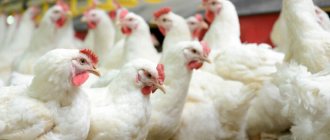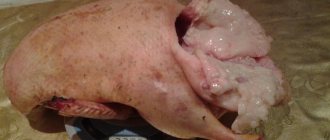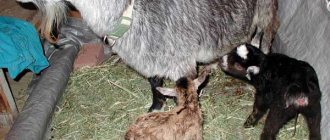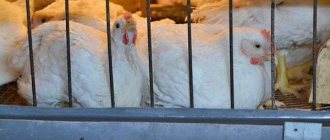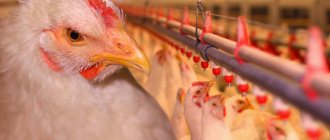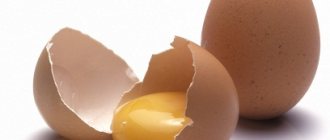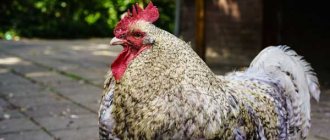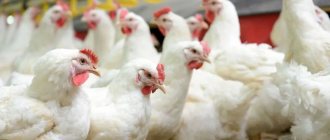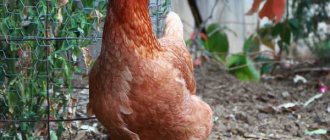Broilers are a meat breed of chicken that is raised specifically for meat. In a short period of time (approximately 45 days), an excellent weight gain can be achieved, at which point the bird is ready for slaughter. Naturally, for this you need to provide proper care by creating the correct diet for feeding broilers and observing the diet.
At poultry farms, broilers are fed mainly with special combined feeds, sometimes with additives that further accelerate the growth of muscle mass. At home, you can save on raising broilers by giving them greens, vegetables, kitchen waste, etc. for food. And if you feed the bird with environmentally friendly feed, you will get tasty, juicy and tender meat.
What is the best food to feed and how to prepare food for broilers with your own hands? How much feed does a broiler eat? What can you feed a bird for rapid growth? We will answer these and other questions in this article.
Feed consumption for broilers, how much feed is needed before slaughter
Broiler chickens are fed twice a day. Consumption per day per adult is about 120 grams, while water consumption is 250 grams. The serving weight per bird increases to 170 grams if succulent feed is included in the diet.
Table of consumption of dry feed (mixed feed) for broilers
| Prestart | Start | Fattening | Finish | |
| Age (days) | 0-5 | 6-18 | 19-37 | 38-42 |
| Gain (in grams) | 15 | 33 | 54 | 56 |
| Daily feed intake (in grams) | 15-21 | 25-89 | 93-128 | 160-170 |
| Feed consumption per broiler per period (in grams per head) | 100 | 760 | 2410 | 830 |
| Daily gain (in grams) | 15,00 | 33,11 | 54,27 | 56,14 |
This feeding scheme provides for proper distribution of the amount of feed at different periods of the life of broilers. The bird receives the necessary amount of substances useful for growth and evenly builds muscle mass.
How much feed is consumed per broiler during the period “Prestart” - “Fattening” - “Finish”
Below is a table that provides more detailed information about the feeding standards of birds from birth to the 26th day, that is, practically during the most critical period of life.
| Broiler age (days) | Live weight (kg per head) | Feed consumption (grams per day per head) | Feed consumption since the beginning of cultivation (grams per head) |
| 0 | 0,042 | 0 | 0 |
| 1 | 0,052 | 14 | 14 |
| 2 | 0,066 | 14 | 28 |
| 3 | 0,082 | 15 | 43 |
| 4 | 0,1 | 16 | 59 |
| 5 | 0,12 | 22 | 81 |
| 6 | 0,142 | 25 | 106 |
| 7 | 0,166 | 28 | 134 |
| 8 | 0,193 | 31 | 165 |
| 9 | 0,223 | 35 | 200 |
| 10 | 0,256 | 39 | 239 |
| 11 | 0,293 | 44 | 283 |
| 12 | 0,334 | 49 | 332 |
| 13 | 0,379 | 55 | 387 |
| 14 | 0,427 | 61 | 448 |
| 15 | 0,478 | 68 | 516 |
| 16 | 0,532 | 75 | 591 |
| 17 | 0,589 | 83 | 672 |
| 18 | 0,649 | 91 | 765 |
| 19 | 0,712 | 99 | 864 |
| 20 | 0,778 | 106 | 970 |
| 21 | 0,846 | 112 | 1082 |
| 22 | 0,916 | 118 | 1200 |
| 23 | 0,988 | 123 | 1323 |
| 24 | 1,062 | 128 | 1451 |
| 25 | 1,137 | 133 | 1584 |
| 26 | 1,213 | 137 | 1721 |
Methods for determining the weight of a chicken
It is very important to monitor the growth of the chicks. To do this, weigh them every day and keep a weight gain table. It is worth noting that in the first month up to 80% of energy is directed towards growth, the rest - towards maintaining key functions of the body.
It is believed that the norm for daily weight gain is 60 grams. A newborn chick weighs approximately 50 grams. Therefore, if you cannot weigh the bird on the first day, then it is better to focus on such data. When a broiler looks different from its relatives of the same age, then in the next month the trend will remain the same.
On day 7, monitor the weight of the young stock every day. This will help detect slow growth and respond to the disease in time. The normal value at this time is 200 g.
At 30 days, babies weigh on average 1.6 kg. If you see that the bird is lagging behind, then carefully check the conditions of detention and diet. At 2 months - approximately 2.7 kg. Feed exclusively with fresh greens and grass. Also during this period, feel free to introduce potatoes mixed with grains into your diet.
Let's figure out how to weigh young animals correctly. To begin, place the chicken in a cardboard box and transfer it to the scale. Carry out this action at least once a week before feeding. Remember, the equipment must be of good quality and produce calculations without errors.
Feeding broiler chickens: types of feed
A balanced diet is the most important factor when raising broilers.
In other words, along with the feed, the chicken should receive all the nutrients, fats, carbohydrates, vitamins and proteins necessary for active growth. The ideal option for feeding is compound feed. After all, not every breeder can independently prepare a balanced diet in calculated proportions, especially if we are talking about a private farmstead. Compound feed is sold ready-made and contains everything that is necessary for broiler chickens to gain weight.
Growth ration (Br-1 or PC 5-2)
Growth feed contains components necessary for growth. The composition, in comparison with the starting mixture, changes slightly. Fats, legumes and salt are added. The amount of wheat is increased, the norms of cake and meal are adjusted in accordance with age needs. The protein group includes bone meal. The dose of vitamins A, D3, E, K3, C, H, and group B is increased.
The norm for two-week-old chicks is 70 g. By the end of the fattening stage, it is gradually increased to 150 g. The diet strengthens the body and promotes weight gain.
How much feed do you need to raise a broiler?
We have already provided a table above, thanks to which you can calculate the feed. But in short, from birth to 2 weeks, chickens should receive 38 grams; from 14 to 28 days, the volume should be increased to 100 grams per day. From 28 to 45 days, 150 grams are consumed per head. In 45 days, the bird should gain 2.6 kg of live weight.
Correct feeding technology involves a gradual increase in the amount of feed. Only in this case will the broiler develop correctly and not spoil the digestive system.
Prohibited Products
To prevent the bird from getting sick and to always have a good appetite, the following should be excluded from the diet:
- all kinds of sweets, such as chocolate;
- fatty dairy products - cheeses and milk;
- citruses;
- sausages and smoked products.
To develop strong bones and muscles in broilers, we recommend giving vitamin complexes that contain all the necessary beneficial components. They are already in the combined feed, but if you feed natural, then you need to use dietary supplements, for example “Kalcemin D”. It should be added in small doses to the drinking bowl every 3 days.
Feed for broiler chickens: which ones to choose
Typically, owners of private farmsteads who raise broilers produce their own feed or purchase the feed that they can get. But if you have a choice, then it is better, of course, to understand the compositions and purchase feed for each period of growing broiler chickens for a balanced diet.
Recently, Best Mix feed has been very popular. Its composition is optimally balanced and contains corn flour, soybeans, wheat and its products, sunflower and its cake, salt, fish meal, soda, mineral and vitamin complexes, amino acids and much more.
The same manufacturer produces vitamin and antibacterial supplements that must be given to broiler chickens in the first days of life. The reviews are mostly positive and if you use products from this brand, you can leave your feedback in the comments.
Important! Broiler feed is selected based on factors such as the age of the bird and its breed. An adult must necessarily receive corn, wheat (crushed), peas, barley, small shells, chalk (we have already listed these components in percentage terms above).
When and how to cut
How long does it take for a broiler to grow - on average, in two months, but the owner makes the decision to cut the livestock on his own when he realizes that the cross has gained the required weight. Most often, domestic livestock is slaughtered at 80 days.
Before the procedure, consider a few rules:
- Chickens should not receive antibiotics for three weeks.
- Do not feed your birds fish waste, minced meat or gravel for two weeks.
- 12 hours before - they are on a starvation diet. It is only allowed to water the chickens.
- To preserve the presentation of chickens, they hold them by their paws. If you grab the wing, bruises will appear. In addition, catch carefully so as not to injure the wings and belly.
There are several slaughter methods:
- External, when a small incision is made at the bottom of the ear using scissors. In this case, the carcass is bled in a couple of minutes.
- Internally, scissors are placed in the chick's beak and the vessels in the throat are trimmed.
Remember that it is professional slaughter that determines the quality of the final product and storage time. The birds are plucked first in hot water, and then the process is completed manually.
Do-it-yourself feed for broiler chickens during the start, fattening and finishing periods
It is not always possible to go to the store and buy ready-made food. However, our site is focused on growing and keeping poultry in private backyards. Therefore, it will not be superfluous to learn how to prepare feed for broilers yourself at home.
Feed recipe for broilers up to 2 weeks
This is a starter feed, but before switching to it, chickens up to 5 days old must be fed finely chopped boiled eggs, low-fat cottage cheese, wet mash prepared with whey, yogurt or milk. If the chickens become airborne, give them a weak solution of manganese.
The starter feed should include:
- Barley (8%);
- Corn dirt (50%);
- Meal or makuhu (14%);
- Finely ground wheat (16%);
- Low-fat kefir or whey (12%).
There is a special feed for hatched chickens - PK-6-1 . But it is much more profitable to prepare your own food based on the above components instead of ready-made granulated food.
Feed recipe for chickens aged 2 to 4 weeks
Such homemade food should consist of:
- Ground corn (48%);
- Wheat dirt (13%);
- Sunflower cake (19%);
- Fish or meat and bone meal (7%);
- Dry skim milk (3%);
- Yeast (5%);
- Feed fat (1%);
- Fresh herbs (3%).
There is factory-made feed PK-6-2 for broiler chickens aged 2 weeks and older. It consists of larger granules and includes meat and bone meal, lysine and vegetable oil.
Feed prepared according to this recipe can be given to broilers until slaughter. Mash can be diluted with curdled milk, whey, and meat broths.
Feed recipe for chickens from 1 month
In essence, you get a finishing feed for broilers with your own hands. If possible, it should include:
- Wheat (25%);
- Barley (25%);
- Peas (10%);
- Corn (20%);
- Soy (20%);
- Sunflower cake (5%).
From the age of 1 month, grain crops such as wheat and barley can be given uncrushed, preferably sprouted.
It is useful to add chalk, fish meal, yeast, and various vitamin and mineral supplements to the above composition.
conclusions
- The growth of broiler breeds is affected by diet and rearing conditions, so you should know how much feed a broiler needs before slaughter.
- An important role when raising birds is given to observing certain periods when the chicks gain weight.
- What distinguishes broilers from other breeds is the effective ratio of the amount of feed to the weight of the bird.
- Poultry farmers use special tables, thereby minimizing feed costs and increasing meat gain.
- By following the correct recommended menu, after two months you will be able to enjoy chicken.
What else is useful to add to broiler feed?
Preparing feed for broiler chickens is not a difficult task, the main thing is to maintain balance. But to keep poultry healthy, its diet (especially chickens) can be supplemented with dairy products (a source of animal protein and calcium):
- Serum;
- Buttermilk;
- Low-fat fresh cottage cheese;
- Reverse;
- Curdled milk.
One important thing to consider here is that if you add milk to the feed, it should not be steamed or sour, otherwise the bird will begin to diarrhea.
Other useful additions to food
Nettle. Rich in vitamins A, E, K, carotene, ascorbic acid, microelements. Especially useful fresh for chickens (can be given from 3 days). You can dry it for the winter.
Grass. It, like nettle, can be given in crushed form to broiler chickens from 2-3 days. For the winter, you can dry hay in bundles and hang it in the chicken coop.
Peas. An excellent source of protein that promotes weight gain and growth. It is better to feed chickens in crushed form as part of wet mash for better absorption.
Bread. The bread contains yeast, which has a beneficial effect on weight gain. It is not advisable to give fresh bread; dried crusts are better. Also, never give moldy bread - it can cause poisoning. Although this product is useful, it is not recommended to add it to the main feed too often.
[ads-pc-1]
BMW
Among poultry farmers, especially those who have an abundance of grain from their own production, protein-vitamin-mineral concentrate is very popular. It is used from 8 days of age in broilers. Until this point, use “Start”.
Compared to the scheme when the feed mixture is prepared from individual ingredients, such feeding can significantly reduce the growing time and ensure high safety of the livestock.
BVMK allows you to quickly and easily enrich feed with the necessary substances without complex measurements - literally from one package. Concentrate:
- ensures high rates of growth and development;
- strengthens the immune system;
- reduces feed costs per unit of production;
- balances the feeding ration according to the main macro-microelements and vitamins;
It is enough to mix the additive with crushed grain in the recommended percentage indicated on the package.
Watering broiler chickens
Birds should always have clean and fresh water. Detailed article on how to properly water chickens. You can learn all about nipple drinkers here. And in this article you will learn how to make a drinking bowl for chickens with your own hands. By the way, vacuum drinkers are recommended for broilers (1 piece per 50 birds).
Basic nutritional requirements
To achieve the full productivity inherent in the genes from a cross, it is necessary to provide the bird with proper nutrition. The most important component in the broiler diet is amino acids . Their role is enormous and, according to degree of importance, is divided into:
- Feather growth.
- Increase in muscle mass.
- The brisket comes out.
- Carcass fat content.
That is, the lack of amino acids primarily affects the feathers. Afterwards, the daily gain decreases, the weight of the brisket decreases and, as a result, the fat content in the carcass drops to minimum values.
The loss of feathers in the absence of parasites is a consequence of violation of feeding standards. Most often, the reason lies in a lack of sulfur, in rare cases – in stress
The yield of brisket is most influenced by sulfur-containing amino acids: methionine and cystine, especially at the final stage of fattening, since there is an additional need for them due to the growth of feathers.
When choosing or preparing feed mixtures, you need to take into account the percentage of amino acids per unit of feed. Another important indicator is the speed and total volume of consumption, which depend on its form. The best results are achieved when using granulated feed. With fine grinding, food is poorly eaten, with coarse grinding, it is digested more slowly.
Making feed yourself gives slightly lower productivity indicators than using high-quality industrial ones. But this approach is economically beneficial if the farmer grows some of the products himself. When you have to buy all the ingredients to create the right diet, it makes sense to analyze the total physical costs (for preparation and storage) and the cost of feed. In some cases (when purchasing at wholesale prices or at a discount, with a small population or with the high cost of individual components in some regions), it is advisable to give preference to ready-made complete mixtures.
Broilers should always have food available, the maximum interval between feedings is no more than 6 hours (at night). The bird must be provided with round-the-clock access to clean drinking water.
What not to feed broilers
Despite the fact that chickens are practically omnivores and often feed on pasture, the following foods are contraindicated for them:
- Vegetable and butter;
- Alcohol and fermentation products;
- New milk;
- Soaked bread;
- Sand too fine;
- Boiled potatoes without anything;
- Stale table waste;
- Sausage;
- Chocolate and cocoa;
- Cheese;
- Citrus peeling;
- Jam.
For stable growth, the diet must be varied and not consist, for example, of only mixed feed. This may cause the bird to refuse other feeds.
Technologies
Certain components used in wet and dry feed mixtures require preliminary preparation.
Yeasting
Yeast is not just poured into a container with food. It is necessary to carry out a fermentation process, as a result of which the feed is saturated with vitamins and is more easily absorbed by the bird.
The required amount of yeast (fodder or regular baker's yeast) is poured with a small volume (1-2 liters) of warm water (its temperature should not exceed 50 ℃) and left for several hours to activate.
The resulting solution is mixed with grain and continued to infuse for 8-10 hours
Malting
No more than 20% of the grain is poured with boiling water in a ratio of 1:2, wrapped and left warm for 4-6 hours. As a result, part of the starch breaks down into sugars, which improves the digestibility and palatability of the feed.
Germination
The grain is filled with water and kept for about 12 hours. After this, the grains are transferred to a colander or bag (for large volumes) to get rid of excess liquid, and placed in a warm place for germination. Some poultry farmers recommend germinating grains in the light and in a layer of no more than 2 cm. But with a large number of birds, such a procedure requires a significant area. Therefore, germination is usually carried out in bags or barrels.
Feeding broilers: some useful tips
- Baker's yeast is very beneficial for the body of chickens. Before adding to food, they are first diluted in warm water (30-40 degrees). For 10 kg of feed you need about 200-300 grams of yeast.
- Broilers eat fresh and untrodden food better, so birds should not get into the feeder with their paws.
- Fill the feeder one-third full to prevent loss and trampling of feed.
- If you notice that a broiler chicken is not eating well, does not come to the feeder, behaves lethargically and begins to weaken, then it needs to be cured. The most effective method is to feed him with a mixture of milk and egg yolk from a pipette 2-3 times.
Benefits of growing
The main feature of hybrid chickens is rapid weight gain. So, in one day a chicken can gain 30-80 g of weight. In addition, raising chickens of this type is associated with other advantages:
- High level of productivity. Chickens are rapidly gaining weight. At 1.5 months they already weigh up to 2.5 kg, and by 2 months they reach 3 kg.
- Unpretentious to living conditions.
- They have high survivability. This figure varies from 94 to 98%.
- They have a fleshy chest and massive legs.
- Unambiguous sales of products.
- Optimal ratio of consumed feed and final product. It is this factor that makes such a business profitable.
Seasonal dietary features
During the cold season, birds' need for calories increases, so broilers are given food with a high content of proteins and carbohydrates. The lack of fresh herbs is compensated by vitamin and mineral supplements. The ability to properly balance nutrition is the main condition for good health of livestock. Mistakes can be detrimental to a sensitive immune system. Even an adult broiler is not always able to survive experiments with nutrition without any consequences. For poultry farms of any size, the combination of high-quality feed and BMWD is considered universal.

